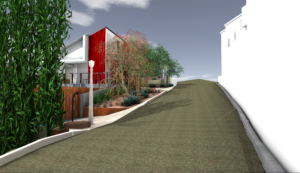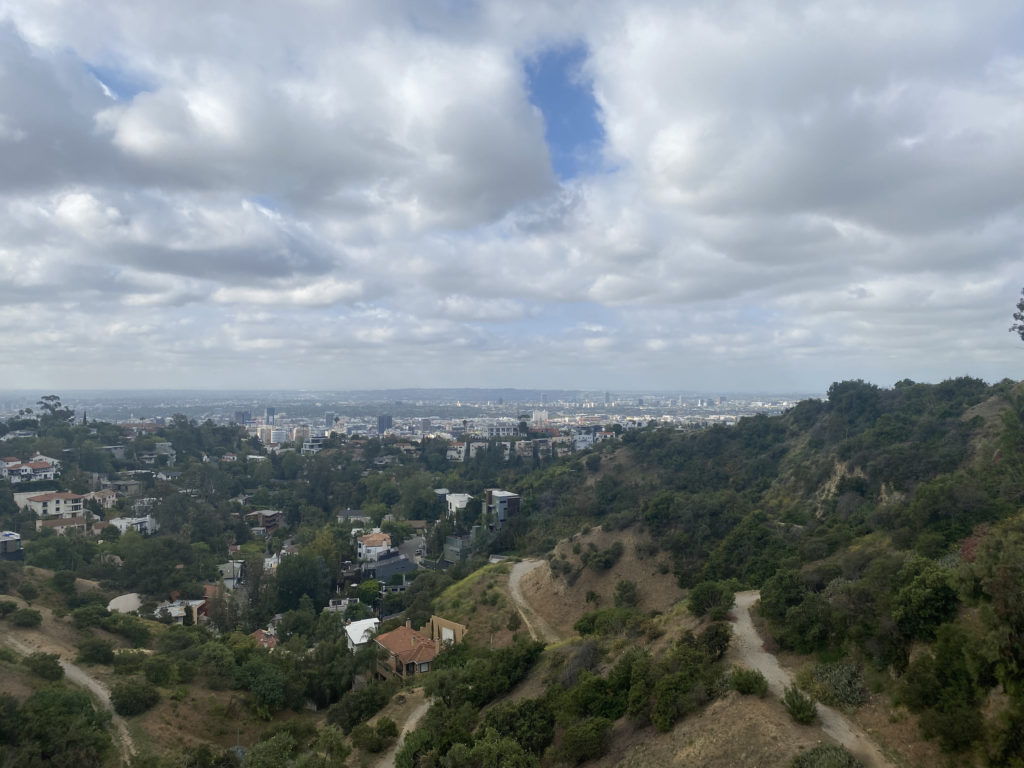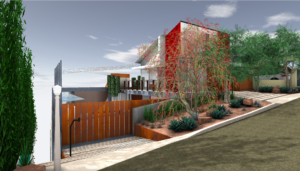Man is nature as much as the trees.
~ Dan Kiley
The DTS Project House Landscape is an aesthetic amenity providing for the contemplation of nature and participation with nature. The landscape is both an optical and spatial experience that connects the DTS Project House to its general and specific locale. The directly adjacent landscape on the property is designed with intentions to intertwine the building with the land it sits on, and the extended off-site landscape and urbanscape are treated as integral parts of the DTS landscape experience.
The DTS landscape’s physical and conceptual interaction with the architecture and the landscape’s natural and manmade material palette physically and conceptually connect the DTS Project House to its specific hillside. The universal aspects of the architecture and the particular aspects of the landscape work to accentuate each other’s character. The ancient technology of earth-bound rock filled gabion screen walls and rammed earth elements made from material excavated from the DTS site literally connect the DTS house to its site and provide a particular natural and organic context for the universal modern technologies of the precise floating manmade steel and glass boxes.
I don’t divide architecture, landscape and gardening: to me they are one..
~ Luis BarraganThe DTS Project House and its landscape are designed to frame, highlight, and extend the DTS landscape from the site through the hills to Hollywood to the Pacific Ocean. In terms used by the architect Le Corbusier, the DTS Project House is an optical machine for viewing the landscape and natural phenomena. The panoramic openings of the major interior spaces and the open roof decks provide expansive uninterrupted views of the immediate landscape all the way to the horizon. The extensive openable glass and roof decks and skylights open to the sky make the sky, clouds, stars, weather, wind, and natural and city light part of the daily experience of the DTS Project House.
The DTS landscape helps frame the experience of the house from on the site and especially from off the site and the building helps frame the experience of the landscape that is both on and off the site. The DTS landscape both shapes the architecture and is revealed by the architecture. The DTS site’s plan dimensions and sloped topography necessitates a multi-story building and the multi-story structure in turn makes the landscape’s chief characteristic, the severe slope, a tangible experience.
The DTS property’s severe slope perfectly aligns with an important aspect of mills studio’s architectural agenda: an element cannot be fully experienced and appreciated from a single perspective or location in space – meaning is enriched as the body moves providing multiple, changing perspectives. Rarely are any landscape elements seen from a single perspective in either plan or elevation. The lower hillside landscape can be viewed at a distance from above and seen as a whole where conceptual patterns are discernable and then can be an up-close tactile and multi-sensory experience as the body moves through open and closed, expansive and confined spaces.
Some elements of the landscape provide either a contemplative optical or a participatory spatial experience, some elements provide both experiences simultaneously, and some landscape elements provide both experiences depending on your body’s relation to the element. The spatial experiences vary from the compressed sideyard canyons to the expansive roof deck gardens to maze like paths to vertical sky spaces.
Landscape elements and spaces provide intimate micro experiences scaled for the individual and expansive group experiences at the macro scale of the neighborhood and city. There are elements that are clearly landscape like planting, and elements, such as the rock filled gabions, that are not strictly building or landscape, but are both simultaneously. Whether considered as strictly landscape or not, every landscape element has both a functional purpose and an aesthetic intention. The functional motivations vary from privacy to shade to circulation to well-being and the aesthetic aims include experiences involving all five senses.
Water is a theme that affects the landscape design from the top to the bottom of the hillside. The absence of water is as significant as its presence. Planting and ground cover choices acknowledge the current high value of water in Southern California. Rain and how it gets from the top of the hill to the bottom for storage is celebrated. Water features using recycled water highlight the movement and sound of water and the lap pool / reflecting pond is an integral sensory and spatial experience of the DTS house entry and daily living.
The DTS Landscape Design eschews a narrow definition of Landscape in favor of a more inclusive definition that includes natural and manmade phenomena as landscape elements. The DTS house and landscape design considers the Landscape to include the immediate, surrounding, and not so near topography and natural features including drainage courses; the vegetation, planting, and ground cover and their containment; the fruits and vegetables grown on site; the site’s geology and minerals; earth retaining; the immediate views and long vistas to Hollywood to downtown Los Angeles to the Pacific Ocean; the Hollywood Sign and Mount Lee; the site’s orientation to the sun creating shade and shadows; the air and wind and breezes; the sky; the immediate micro climate and distant weather from clouds to rain to lightning; and the night time city lights and stars.
A site or landscape does not exist—except as our eyes see it. The idea therefore is to make it visibly present, choosing the best of the whole or parts of it. Tis source of inestimable benefit must be gasped. A site or a landscape is made of vegetation seen close up, of stretches of level or uneven terrain, or horizons seen at a distance or right in front of us. Climate places its stamp on the whole, dictating what is fit to survive and develop there. Its presence will always be felt both in what surrounds the constructed things as a volume and the reasons which had so much to do with deciding on the very shape of the constructed thing.
~ LeCorbusier
Creston Garden
The DTS Project House introduces itself to the immediate neighborhood with a garden. Unlike most houses along Creston and Durand Drive that confront the street with either the wall of the house, or a solid stucco wall or planting that is taller than eye level, the DTS Project House is set back from the street providing an open garden space to the street acknowledging the pedestrian character of the neighborhood. Along with the two driveways of earth colored spaced concrete the garden is a golden gravel ground cover with boulders excavated from the site. A low wall of vertical board formed concrete demarcates the transition from garden to house and motor court.
The Creston Drive garden has a focal tree, several secondary trees, and a lower undergrowth of different heights. The plant ensemble provides a variety of natural structures, flowering seasons, and colors from green foliage to red, white, brown, and yellow flowering. Many of the plants attract hummingbirds adding to the garden’s full sensory experience as you walk along Creston Drive or pass through the garden to enter the property. The garden is equally for the house and for the neighborhood.

A 30’ tall (when mature) columnar Weeping Bottlebrush tree helps to mediate the scale of the building portion adjacent to the street and along with providing a natural organic foil to the architecture, the tree is positioned to provide privacy from the neighbor looking down on the DTS Project House from across the street. The Weeping Bottlebrush also adds landscape visible from the Motorcourt located adjacent to and below the Creston Garden. Several less dense Cajeput trees provide multi-trunk structures with a tactile paper-like peeling white bark.
The gardens “undergrowth” includes the three to four feet tall upright thin branches of Small Cape Rush and the similar height hybrid Blue Flame Agave provide yellow flowers toward the end of the year. Low spreading Prostrate Rosemary provides a dark green ground cover and pale blue flowers in winter. Succulent Giant Chalk Dudleya, a low rosette of white to silver gray leaves covered with chalk have up to 24” long reddish-violet spikes that open with pale yellow flowers in late spring to summer.
Motor court
The DTS Project House’s motor court is an urban space in the sense that it is completely surrounded by architecture. The plaza is an inwardly focused space enclosed on all sides, open only to the sky. But the experience of the enclosing architecture is complemented with natural landscape and hardscape elements either located in the motor court or experienced from the motor court. Among the motor court’s functional purposes is as a transition between the street and garage for vehicles; a pedestrian circulation space connecting the street and secondary house entrance; a place for guest parking; and as an outdoor gathering space. Day to day the Owners’ chief experience of the motor court is through the windshield of a car and then a short stroll across the plaza from the garage to the house.
The outside is always an inside.
~ Le CorbusierSusan’s Floating Garden
Floating above the motor court on the Upper Garage Level is an intimate private garden just off of Susan’s Office. A series of different height and diameter cylindrical hydroponic plant structures are attached to the side of a steel and wood deck platform so as to appear to float in space unsupported. The top and bottom elevations of the circular plant volumes vary but the top elevations are all above eye level when seated or reclining in the garden creating an enclosed landscape open to the sky. The plant structure’s heights allow for view glimpses when standing on the deck and serve as the deck’s guardrail.
The plant volumes are exposed on both the top and bottom making it possible to visually experience the floating garden from multiple perspectives – from the side, from above, and from below. When you drive in the motor court gate you look up at the plant volumes through the windshield. You walk underneath the floating garden as you walk from the garage or motor court to the house’s entry. As you walk up the interior stair from the Intermediate Level toward the Lower Garage Level you see the plant volumes through the glass and your view changes with each stair riser. If you look up through the pool’s glass roof while swimming laps you glimpse the green and flowering colors of the floating garden three stories above.
Parking in the Upper Garage and walking to the building entry a level below takes you first to an exterior landing and then down a flight of stairs. When you exit the garage door and turn left on the landing five floating plant cylinders are your primary view with the top of the planting just below eye level. As you go down the stair your perspective changes from seeing the top of the cylinders, to an elevational view, to oblique views from below, to looking up the length of the cylinders, to walking underneath the cylinders as they become circles. The floating garden has an inside and an outside. The inside is an intimate individual tactile experience and the outside is a distant visual experience
The fact that garden making is in part a science does not free it from the duty of performing an aesthetic function; it can no more be turned over to horticulturalist than architecture to the engineer.
~ Christopher Tunnard



